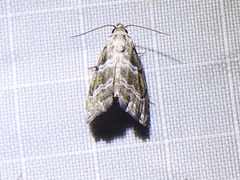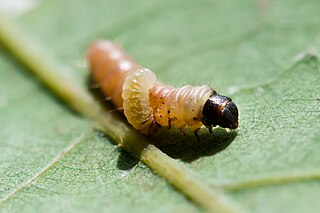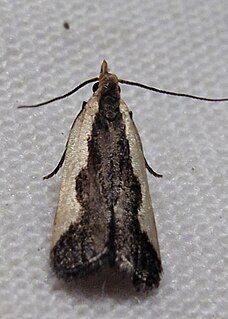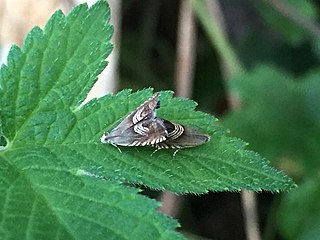
Abablemma is a genus of moths in the family Erebidae. The genus was described by Nye in 1910.

The Depressariinae – sometimes spelled "Depressiinae" in error – are a subfamily of moths in the superfamily Gelechioidea. Like their relatives therein, their exact relationships are not yet very well resolved. It has been considered part of family Elachistidae sensu lato or included in an expanded Oecophoridae. In modern classifications they are treated as the distinct gelechioid family Depressariidae.

Psilocorsis cryptolechiella is a moth of the family Depressariidae. It is found in the United States, including Alabama, Illinois, Massachusetts, Pennsylvania and South Carolina.

Psilocorsis quercicella is a species of moth of the family Depressariidae. It is found in the United States, including Florida, Maryland, Massachusetts and Oklahoma.

Psilocorsis is a genus of moths of the family Depressariidae.
Agonopterix hesphoea is a moth in the family Depressariidae. It was described by Ronald W. Hodges in 1975. It is found in North America, where it has been recorded from Texas.
Psilocorsis propriella is a moth in the family Depressariidae. It was described by Zeller in 1877. It is found in Colombia.
Psilocorsis purpurascens is a moth in the family Depressariidae. It was described by Walsingham in 1912. It is found in Guatemala.
Psilocorsis exagitata is a moth in the family Depressariidae. It was described by Edward Meyrick in 1926. It is found in Colombia.
Psilocorsis amydra is a moth in the family Depressariidae. It was described by Ronald W. Hodges in 1961. It is found in North America, where it has been recorded from Arizona.
Psilocorsis arguta is a moth in the family Depressariidae. It was described by Ronald W. Hodges in 1961. It is found in North America, where it has been recorded from Arizona.
Psilocorsis cirrhoptera is a moth in the family Depressariidae. It was described by Ronald W. Hodges in 1961. It is found in North America, where it has been recorded from Arizona.
Psilocorsis carpocapsella is a moth in the family Depressariidae. It was described by Francis Walker in 1864. It is found in Brazil.
Psilocorsis indalma is a moth in the family Depressariidae. It was described by Walsingham in 1912. It is found in Guatemala.
Psilocorsis melanophthalma is a moth in the family Depressariidae. It was described by Edward Meyrick in 1928. It is found in Colombia.

Dichomeris aleatrix, the buffy dichomeris moth, is a moth in the family Gelechiidae. It was described by Ronald W. Hodges in 1986. It is found in North America, where it has been recorded from southern Ontario south to Tennessee and north to Illinois.
Dichomeris bolize, or Glaser's dichomeris moth, is a moth in the family Gelechiidae. It was described by Ronald W. Hodges in 1986. It is found in the United States, where it has been recorded from Nebraska, Connecticut, Florida, Maryland, Massachusetts, New Jersey, New York, North Carolina and Texas.
Ronald William Hodges, known as Ron, was an American entomologist and lepidopterist.

Grapholita delineana, known generally as Eurasian hemp moth, is a species of tortricid moth in the family Tortricidae. Other common names include the hemp moth and hemp borer.

A MONA number, or Hodges number after Ronald W. Hodges, is part of a numbering system for North American moths found north of Mexico in the Continental United States and Canada, as well as the island of Greenland. Introduced in 1983 by Hodges through the publication of Check List of the Lepidoptera of America North of Mexico, the system began an ongoing numeration process in order to compile a list of the over 12,000 moths of North America north of Mexico. The system numbers moths within the same family close together for identification purposes. For example, the species Epimartyria auricrinella begins the numbering system at 0001 while Epimartyria pardella is numbered 0002.






